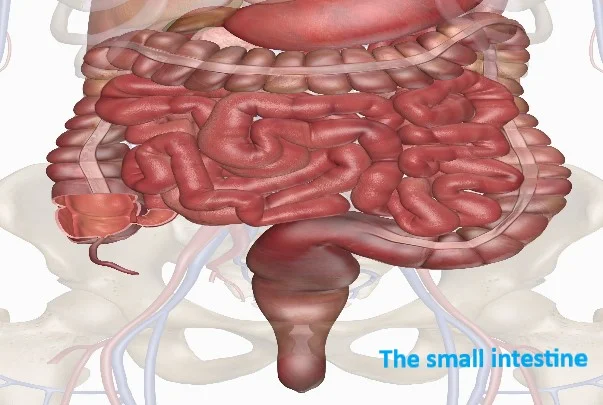The small intestine or small intestine is the organ of the digestive system that absorbs nutrients primarily from food. Located between the stomach and large intestine, it receives bile and the pancreas through the pancreatic duct to aid in digestion. The small intestine is about 6.5 meters long and can be bent several times to conform to the abdomen.
Small intestine - the volume of the small intestine and the parts of the intestine per minute
Although longer than the large intestine, it is called the small
intestine because of its narrower diameter.
The small intestine is made
up of three distinct regions: the duodenum, the jejunum, and the ileum. On the
shorter duodenum, preparation for suction begins through tiny projections
resembling so-called villi. Fasting is absorbed solely through the lining of
gut cells: small molecule nutrients previously digested by enzymes in
the duodenum. The main function of the ileum is to absorb vitamin B12, bile
salts and all digestive products that are not absorbed by the jejunum.
Small intestine size
The length of the small intestine varies
greatly, from 3.00 m (9.84 ft) to 10.49 m (34.4 ft), depending on the
measurement technique used. The
typical height of a living person is 3 m - 5 m .Height
depends on how a person's height and height are measured. Larger individuals generally have a longer
small intestine and are generally longer when measured after death and
after emptying.
After 9
weeks of gestation, infants are approximately 1.5 centimeters in diameter, and
adults are 2.5 to 3 centimeters (3 inches). In abdominal examination, the
small intestine is abnormal when its diameter is more than 3 cm. In
computed tomography, more than 2.5 cm in diameter is considered abnormal
irrigated. The surface of the human small intestine's brain cortex, due
to hypertrophy of the folds, valves, and microwaves, an average of 30 square meters.
Parts of the small intestine:-
The small intestine is divided into three phases.small intestine parts.
· The duodenum is short and measures 20cm (7.9cm) by 25cm (9.8cm) and has
a "C" shape. Surrounding his severed head. Gastric juice is absorbed
in the stomach along with juices from the gallbladder (digestive enzymes) and
liver (bile). Proteins break down the proteins and micelles produced by bile.
· The duodenum contains Bruner's gland, which produces acid-rich acids,
including bicarbonate. These acids, along with the bicarbonate of the
gallbladder, cause stomach acid in the stomach.
The jejunum is the central part of the small intestine, which connects
the duodenum and the ileum. It is 2.5 meters long and has a circle with
intestinal fibers in place. Fatty acids (sugar, amino acids, fatty acids) enter
the muscles here. The suspensory muscles of the duodenum show the difference
between the duodenum and the jejunum.
Ileus: the end of the small intestine. It is 3 meters high and has a
villa like a person who fasts. Contains vitamin B12 and acetic acid as well as nutrients. The ileum
connects the large intestine to the esophageal sphincter.
The jejunum and ileum were removed from the abdominal cavity and mesentery. The deer is part of the peritoneum. Blood vessels, nerves, muscles and nerves enter the heart.
The small intestine is a long tube that connects the stomach to the large intestine. It is the primary site for digestion of food, which happens when food passes through the intestine. The small intestine is responsible for the absorption of nutrients from the food we eat, which then goes on to the body for use. The small intestine is also the site of the absorption of water and other nutrients that the body needs but cannot use.


